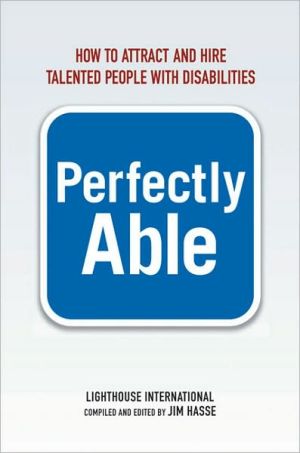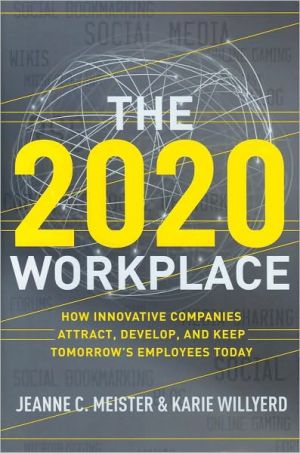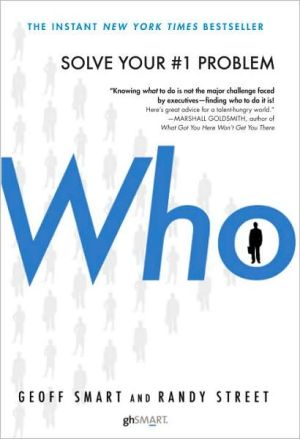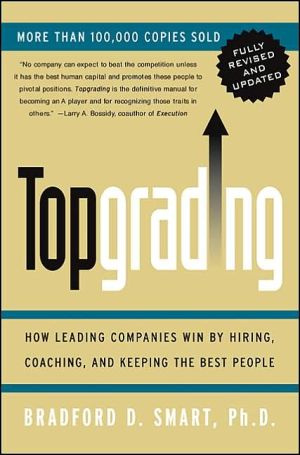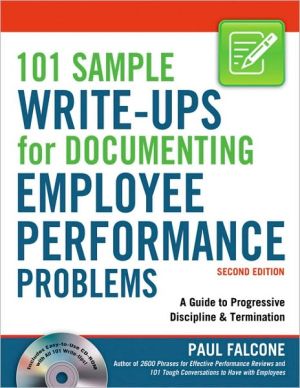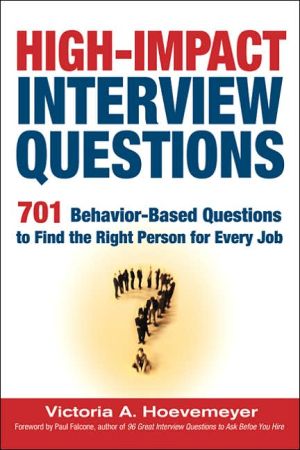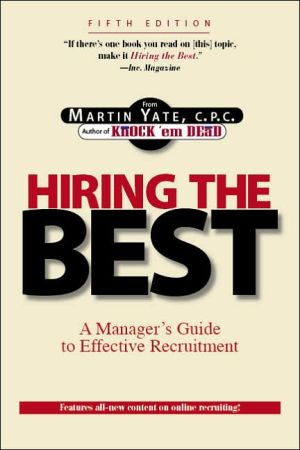Perfectly Able: How to Attract and Hire Talented People with Disabilities
Perfectly Able is your all-in-one guide to finding and keeping some of your best, most valuable employees. Packed with firsthand accounts of how people with disabilities handle workplace challenges and real-world examples of innovative HR strategies used by major corporations, Perfectly Able offers insights from eSight Careers Network, Lighthouse International’s online resource for job seekers, employers, and small businesses. The book:\ • Provides useful information about how to recruit...
Search in google:
Advance Praise for Perfectly Able:“Too many employers and their recruiters are unaware that addressing a disability is often only a matter of mechanics. There’s a too-common assumption that being disabled means being unable. That robs an employer of the opportunity to consider people with disabilities as intelligent, capable, and often innovative people who just happen to have some faculty in disrepair.” — Katy Jo Meyer, technical recruiter, Microsoft Corporation“We need a constructive dialogue between job seekers with disabilities and employers. Both are passing each other by—sometimes missing each other by miles. This book is intended to assist all employers and all job seekers to find one another. Not connecting is a loss for us all.” — John D. Kemp, Executive Director, U.S. Business Leadership Network “Perfectly Able is full of insight and practical help for both job applicants and employers [that] is utterly compelling and convincing. . . . Every employer in the world should have a copy on his or her desk.” — Robert W. Fuller, former President of Oberlin College and author of Somebodies and Nobodies: Overcoming the Abuse of Rank
CHAPTER 1: GAIN A BETTER AWARENESS OF DISABILITY\ This chapter gives you an overview of the concept of employing disabled\ workers. It explores the reasons why your workforce will increasingly\ include workers with disabilities. This will happen in the natural\ course of events as seniors keep working longer, but there also are solid\ reasons for seeking out disabled people to improve your workforce. If\ you leave disability awareness out of your diversity program, you truly\ shortchange your company and your employees. This chapter also discusses\ methods of incorporating disabled employees into your workforce\ and describes the benefits your company will derive from hiring\ qualified workers with disabilities.\ How Inclusive Recruiting Will Help You Prepare for Coming Changes in the Employment Landscape\ For most businesses today, diversity no longer means recruiting “minority”\ groups so the employment numbers look “representative” on paper.\ Instead, diversity is all about capturing and retaining individuals who\ are creative and talented—and doing that by fostering a workplace climate\ that recognizes, values, and supports ideas from every direction.\ Diversity is inclusion. Diversity is embracing differences. It’s the only\ way to compete as a business in today’s marketplace.\ In 2006, the overall percentage (prevalence rate) of working-age (21\ to 64) people with a disability in the United States was 12.9 percent,\ according to the U.S. Census Bureau’s American Community Survey. In\ other words, 22,382,000 of the 172,961,000 working-age individuals\ reported one or more disabilities.\ Are your competitors overlooking nearly 13 percent of the labor market?\ If they are, they are in trouble. And you can gain an edge over them.\ You can do this by embracing differences in both employees and customers;\ hiring the best talent within this pool of working-age people with\ disabilities; and taking advantage of two colliding, long-range population\ trends.\ A Wake-Up Call\ The Workforce 2000 Study, researched and written by the Hudson\ Institute for the U.S. Department of Labor, clearly demonstrates the need\ for employers seeking a well-qualified workforce to look beyond the prevailing\ white, male population, which actually makes up only one-fourth\ of the U.S. workforce.\ The study shows that qualified workers are becoming more difficult\ to identify (what DuPont calls “The Great American Manpower Search”)\ and that aggressive employers need to plan for diversity and recruit qualified\ people with disabilities if they are to remain competitive.\ As a business executive, you track trends that may have an impact on\ your company’s future well-being. Some of the most important trends\ are about your workforce.\ After all, unemployment isn’t just about people being out of work. It’s\ also about businesses being able to draw on and support a productive\ workforce. Keeping on top of population trends gives you the preparation\ time you need to tap and strengthen the best potential workers\ available.\ Any single trend in the available workforce is important to you.\ Sometimes more than one trend will overlap, but this isn’t always starkly\ evident from an employment perspective. You may hear, “There will be\ twice as many X in the workforce,” but not about some other trend\ affecting X (such as a population drift, the introduction of new philosophies\ about training those future employees, or health issues increasingly\ affecting that group).\ Still, you may be getting only half the story if you aren’t tracking\ these collateral trends as well. What good is it to know that your work-\ force will need to draw on, say, more mothers with school-age children,\ if those women are migrating to rural areas far from your facilities?\ Two trends that do overlap and will color your decisions about\ human resources in the next two or three decades involve the increasingly\ older workforce.\ Two Colliding Trends\ In the United States in the 32 years between 1998 and 2030, more seniors\ will return to work after retirement or postpone retirement and the\ number of people who are blind is expected to double to at least 19.2\ million, according to a 2007 Lou Harris poll conducted for Lighthouse\ International. Will your company be ready?\ Each of the first three decades of the twenty-first century will\ add 25 million more Americans over age 65, according to Federal\ Interagency Forum on Aging-Related Statistics (see http://www.aoa.gov/\ agingstatsdotnet/Main_Site/Data/2008_Documents/Population.aspx).\ These aging baby boomers “may be headed for a financial crisis, because\ they have saved, on average, only 12 percent of what they believe they\ will need to meet basic living expenses during retirement,” a crisis that\ will cause them to delay or interrupt their retirement to bring in an\ income (“Allstate Financial ‘Retirement Reality Check’ Reveals Financial\ Crisis for Baby Boomers Heading into Retirement,” PR Newswire, at\ http://tinyurl.com/apyegq).\ Many of those baby boomers may become disabled. For example,\ consider this collateral trend: According to the Allstate study, “Over one\ million Americans aged 40 and over are currently blind, and an additional\ 2.4 million are visually impaired. These numbers are expected to\ double over the next 30 years as the baby boomer generation ages.”\ Let’s put this into a larger context. According to the U.S. Census\ Bureau, 51.8 percent of Americans aged 65 and older in 2005 were estimated\ to have a disability (“Americans with Disabilities: 2005,” U.S.\ Census Bureau, issued December 2008, http://www.census.gov/prod/\ 2008pubs/p70-117.pdf).\ Although clearly not all of the over-65 workers you eventually retain,\ rehire, or add to your workforce will be disabled, it is likely you will be\ increasingly required to address a range of workplace accessibility\ issues. Workers who do not regard themselves as disabled but who do\ need assistance may not be familiar with the many tools that they can\ use to keep working productively. It will largely be up to you to prepare\ for this eventuality.
Foreword: Roads More Easily TraveledPreface: An Opportunity---Not a ResponsibilityAcknowledgmentsChapter 1 Gain a Better Awareness of Disability 1How Inclusive Recruiting Will Help You Prepare for Coming Changes in the Employment Landscape 1Why Your Diversity Initiative Needs to Include Disability 8How to Choose the Right Disability Awareness Trainer for Your Company 11The Right to Self-Determination for Individuals with a Disability in Today's Workplace 13How Individuals with a Disability Define Inclusion 19The Role of Maturity and Self-Esteem in an Individual's Approach to Disability 22How Learning to Live Well with a Disability Can Have an Upside 26Chapter 2 Foster a Company Culture That Is Receptive to Disability 33Put Your Diversity Values into Practice 33Create a Work Environment That Values Diversity 36Workplace Interdependence Makes Disability Irrelevant 41Bridge Builders Can Be Valuable to Your Corporate Culture 45Job Seekers with a Disability Can Add Elasticity to Your Workforce 51How You'll Know Your Inclusion Efforts Are Working 55Chapter 3 Make Your Recruiting Efforts Disability Inclusive 63Frequently Asked Questions About Hiring Employees with Disabilities 63What You as an Employer Need to Know About Current Interpretations of the ADA 67Considering Volunteer Experience May Be Essential in Fully Evaluating a Job Candidate 80Not All Volunteer Work Is the Same When Evaluating a Job Candidate 85How to Locate Job Candidates with Disabilities on the Local Level 89Using Job Fairs to Recruit Candidates with a Disability 92Locating Job Candidates with Disabilities Online 98Recruiting Qualified Job Candidates with Disabilities on College Campuses 104How to Make Your Screening Process Inclusive 110Four Barriers Job Candidates with a Disability Encounter When They Interview for a Job 114Chapter 4 Identify Job Candidates Who Will Thrive in Your Corporate Culture 121Job Candidates Who Approach Employment from an Entrepreneurial Perspective 121Job Seekers Who Are Successfully Operating Small Businesses 123People Who Have Moved Beyond Self-Absorption to Become Fully Engaged Members of Society 127Individuals Who Take Personal Responsibility When They Become "Easy Marks" While at Work 131How to Identify Individuals with Emotional Intelligence 137Job Candidates Who Can Gracefully Accept and Decline Help 142Job Candidates Who Can Carry Their Load as Members of Your Team 145Job Seekers Who Possess the Authenticity Valued in the Business World 150Targeting Candidates Who Are Willing to Take Reasonable Risks 155Chapter 5 Approach People Management from a Disability Perspective 163How Self-Esteem Affects Workplace Performance and Behavior 163Avoiding Paternalism in the Workplace 170Assigning a Mentor for Your Newly Hired Employee with a Disability 177Using Your Leadership to Help an Employee with a Disability Grow in His Job 182Removing Intentional and Unintentional Barriers to Achievement for Employees with a Disability 185Adaptive Technology Is Making Major Forms of Disability Irrelevant in the Workplace 191FAQ: Guidelines on Reasonable Accommodations for Employees with Disabilities Under the ADA 200Accommodations for Adaptive Technology: Who Should Pay for What Under What Circumstances 211When a Worker with a Disability Tries to Put One Over on You 216FAQ: Guidelines on Confidentiality for Employees with Disabilities under the ADA 217How to Prevent a Disability Discrimination Lawsuit 221Curtis Bryan and Randy Hammer Make Blindness Irrelevant in Serving Customers 224Appendix A Comprehensive Resource List for Hiring People with Disabilities 231Appendix B About eSight Careers Network 239Appendix C eSight Careers Network Article Links 243Index 247
\ From the Publisher“… excellent resource for any employer…important book with information that no businessperson can afford to ignore. “\ --Terri Schlichenmeyer, national columnist of The Bookworm\ \ \
